Pesma o Nibelunzima — разлика између измена
. |
(нема разлике)
|
Верзија на датум 21. децембар 2019. у 23:01

Један корисник управо ради на овом чланку. Молимо остале кориснике да му допусте да заврши са радом. Ако имате коментаре и питања у вези са чланком, користите страницу за разговор.
Хвала на стрпљењу. Када радови буду завршени, овај шаблон ће бити уклоњен. Напомене
|
nem. Nibelungenlied (Der Nibelunge nôt), u prevodu Pesma o Nibelunzima, je epska pesma napisana oko 1200 u srednjem visokonemačkom. Its anonymous poet was likely from the region of Passau. The Nibelungenlied is based on an oral tradition that has some of its origin in historic events and individuals of the 5th and 6th centuries and that spread throughout almost all of Germanic-speaking Europe. Parallels to the German poem from Scandinavia are found especially in the heroic lays of the Poetic Edda and in the Völsunga saga.
The poem is split into two parts: in the first part, Siegfried comes to Worms to acquire the hand of the Burgundian princess Kriemhild from her brother King Gunther. Gunther agrees to let Siegfried marry Kriemhild if Siegfried helps Gunther acquire the warrior-queen Brünhild as his wife. Siegfried does this and marries Kriemhild; however Brünhild and Kriemhild become rivals, leading eventually to Siegfried's murder by the Burgundian vassal Hagen with Gunther's involvement. In the second part, the widow Kriemhild is married to Etzel, king of the Huns. She later invites her brother and his court to visit Etzel's kingdom intending to kill Hagen. Her revenge results in the death of all the Burgundians who came to Etzel's court as well as the destruction of Etzel's kingdom and the death of Kriemhild herself.
The Nibelungenlied was the first heroic epic put into writing in Germany, helping to found a larger genre of written heroic poetry. The poem's tragedy appears to have bothered its medieval audience, and very early on a sequel was written, the Nibelungenklage, which made the tragedy less final. The poem was forgotten after around 1500, but was rediscovered in 1755. Dubbed the "German Iliad", the Nibelungenlied began a new life as the German national epic. The poem was appropriated for nationalist purposes and was heavily used in anti-democratic, reactionary, and National-Socialist propaganda before and during the Second World War. Its legacy today is most visible in Richard Wagner's operatic cycle Der Ring des Nibelungen, which, however, is mostly based on Old Norse sources. In 2009, the three main manuscripts of the Nibelungenlied[1] were inscribed in UNESCO's Memory of the World Register in recognition of their historical significance.[2] It has been called "one of the most impressive, and certainly the most powerful, of the German epics of the Middle Ages."[3]

Izvori manuskripta

The poem in its various written forms was lost by the end of the 16th century, but manuscripts from as early as the 13th century were re-discovered during the 18th century.[4] There are thirty-seven known manuscripts of the Nibelungenlied and its variant versions.[5] Eleven of these manuscripts are essentially complete.[6] The oldest version seems to be the one preserved in manuscript "B". Twenty-four manuscripts are in various fragmentary states of completion, including one version in Dutch (manuscript 'T').
Izdanja
(u hronološkom redosledu)
- Lachmann, Karl, ур. (1826). Der Nibelunge not mit der klage : in der ältesten gestalt (1 изд.). Berlin: G. Reimer.
- Lachmann, Karl, ур. (1841). Der Nibelunge noth und die klage : nach der ältesten überlieferung (2 изд.). Berlin: G. Reimer.
- Lachmann, Karl, ур. (1851). Der Nibelunge noth und die klage : nach der ältesten überlieferung (3 изд.). Berlin: G. Reimer.
- Lachmann, Karl, ур. (1867). Der Nibelunge noth und die klage : nach der ältesten überlieferung (4 (6th print of the text) изд.). Berlin: Georg Reimer.
- Lachmann, Karl, ур. (1877). Der Nibelunge noth und die klage : nach der ältesten überlieferung ((9th print of the text) изд.). Berlin: G. Reimer.
- Das Nibelungenlied in der ältesten Gestalt mit den Veränderungen des gemeinen Textes. Herausgegeben und mit einem Wörterbuch versehen von Adolf Holtzmann. Stuttgart 1857 (Google, Google)
- Karl Bartsch, Der Nibelunge Nôt : mit den Abweichungen von der Nibelunge Liet, den Lesarten sämmtlicher Handschriften und einem Wörterbuche, Leipzig: F. A. Brockhaus, 1870–1880
- Michael S. Batts. Das Nibelungenlied, critical edition, Tübingen: M. Niemeyer 1971. ISBN 3-484-10149-0
- Helmut de Boor. Das Nibelungenlied, 22nd revised and expanded edition, ed. Roswitha Wisniewski, Wiesbaden 1988, ISBN 3-7653-0373-9. This edition is based ultimately on that of Bartsch.
- Ursula Schulze, Das Nibelungenlied, Düsseldorf / Zürich: Artemis & Winkler 2005. ISBN 3-538-06990-5. Based on manuscript C.
- Hermann Reichert, Das Nibelungenlied, Berlin: de Gruyter 2005. VII, ISBN 3-11-018423-0. Edition of manuscript B, normalized text; introduction in German.
- Walter Kofler (Ed.), Nibelungenlied und Klage. Redaktion I, Stuttgart: Hirzel 2011. ISBN 978-3-7776-2145-6. Manuscript I.
- Walter Kofler (Ed.), Nibelungenlied. Redaktion D, Stuttgart: Hirzel 2012. ISBN 978-3-7776-2297-2. Manuscript D.
- Heinzle, Joachim, ур. (2013). Das Nibelungenlied und die Klage. Nach der Handschrift 857 der Stiftsbibliothek St. Gallen. Mittelhochdeutscher Text, Übersetzung und Kommentar. Berlin: Deutscher Klassiker Verlag. ISBN 978-3-618-66120-7. Text, translation and commentary, based on manuscript B.
Prevodi i adaptacije
Engleski
- Alice Horton, Translator. The Lay of the Nibelungs: Metrically Translated from the Old German Text, G. Bell and Sons, London, 1898. [1] Line by line translation of the "B manuscript". (Deemed the most accurate of the "older translations" in Encyclopedia of literary translation into English: M-Z, Volume 2, edited by Olive Classe, 2000, Taylor & Francis, pp. 999–1000.)
- Margaret Armour, Translator. Franz Schoenberner, Introduction. Edy Legrand, Illustrator. The Nibelungenlied, Heritage Press, New York, 1961
- Arthur Thomas Hatto, The Nibelungenlied, Penguin Classics 1964. English translation and extensive critical and historical appendices.
- Robert Lichtenstein. The Nibelungenlied, Translated and introduced by Robert Lichtenstein. (Studies in German Language and Literature Number: 9). Edwin Mellen Press, 1992. ISBN 0-7734-9470-7. ISBN 978-0-7734-9470-1.
- Burton Raffel, Das Nibelungenlied, new translation. Foreword by Michael Dirda. Introduction by Edward R. Haymes. Yale University Press 2006. ISBN 978-0-300-11320-4. ISBN 0-300-11320-X
- Michael Manning (Illustrator), Erwin Tschofen (Author), sum legio publishing, 2010. ISBN 978-3-9502635-8-9.
- Cyril Edwards, The Nibelungenlied. The Lay of the Nibelungs, translated with an introduction and notes. Oxford University Press 2010. ISBN 978-0-19-923854-5.
- William T. Whobrey, The Nibelungenlied: with The Klage, Edited and Translated, with an Introduction, by William T. Whobrey. Hackett Publishing Company 2018. ISBN 978-1-62466-675-9.
Moderni nemački
- Das Nibelungenlied. Translated by Karl Bartsch. Leipzig 1867 (Google)
- Das Nibelungenlied. Translated by Karl Simrock. Stuttgart 1868 (Google)
- Das Nibelungenlied. Zweisprachig, parallel text, edited and translated by Helmut de Boor. Sammlung Dieterich, 4th edition, Leipzig 1992, ISBN 3-7350-0104-1.
- Das Nibelungenlied. Mhd./Nhd., parallel text based on the edition of Karl Bartsch and Helmut de Boor, translated with commentary by Siegfried Grosse. Reclam Universal-Bibliothek. Band 644. Reclam, Stuttgart 1997, ISBN 3-15-000644-9.
- Albrecht Behmel, Das Nibelungenlied, translation, Ibidem Verlag, 2nd edition, Stuttgart 2001, ISBN 978-3-89821-145-1
Italijanski
- Laura Mancinelli, I Nibelunghi, Translated in Italian from the Old German Text with an introduction and notes, Giulio Einaudi Editore, Turin 1972, ISBN 978-88-06-23661-8
Reference
- ^ Designated as A (today in Munich, Bayerische Staatsbiblitohek), B (today in St. Gallen, Stiftsbiblitohek) and C (today in Karlsruhe, Baden State Library
- ^ UNESCO 2009.
- ^ Garland & Garland 1997.
- ^ Savage, Bryn. „Creating Germany's National Myth”. yale.edu. Yale University. Приступљено 16. 7. 2017.
- ^ See Handschriftencensus
- ^ The Donaueschingen manuscript C (today conserved in Karlsruhe, Baden State Library)can be considered as the longest version, although some pages are missing „Archived copy”. Архивирано из оригинала 2006-06-16. г. Приступљено 2006-06-16.
Literatura
- Bekker, Hugo (1971). The Nibelungenlied: A Literary Analysis
 . Toronto: University of Toronto. ISBN 978-0802052353.
. Toronto: University of Toronto. ISBN 978-0802052353. - Bumke, Joachim (1996). Die vier Fassungen der "Nibelungenklage". Untersuchungen zur Überlieferungsgeschichte und Textkritik der höfischen Epik im 13. Jahrhundert. Berlin/New York: de Gruyter.
- Curschmann M (1987). „'Nibelungenlied' und 'Klage'”. Ур.: Ruh K, Keil G, Schröder W. Die deutsche Literatur des Mittelalters. Verfasserlexikon. 2. Berlin, New York: Walter De Gruyter. cols 926–969. ISBN 978-3-11-022248-7.
- Garland, Henry; Garland, Mary (1997). „Nibelungenlied”. The Oxford Companion to German Literature (3 изд.). Oxford and New York: Oxford University. ISBN 9780191727412.
- Gentry, Francis G.; McConnell, Winder; Müller, Ulrich; Wunderlich, Werner, ур. (2011) [2002]. The Nibelungen Tradition. An Encyclopedia. New York, Abingdon: Routledge. ISBN 0-8153-1785-9.
- Handschriftencensus (2018). „Gesamtverzeichnis Autoren/Werke: 'Nibelungenlied'”. Handschriftencensus. Приступљено 3. 5. 2018.
- Haymes, Edward R.; Samples, Susan T. (1996). Heroic legends of the North: an introduction to the Nibelung and Dietrich cycles. New York: Garland. стр. 101—111. ISBN 0815300336.
- Heinzle, Joachim (1999). Einführung in die mittelhochdeutsche Dietrichepik. Berlin, New York: De Gruyter. ISBN 3-11-015094-8.
- Heusler, Andreas (1982) [1965]. Nibelungensage und Nibelungenlied. Die Stoffgechichte des Deutschen Heldenepos (6th изд.). Darmstadt: Wissenschaftliche Buchgesellschaft. ISBN 3-534-06960-9.
- Hoffmann, Werner (1974). Mittelhochdeutsche Heldendichtung. Berlin: Erich Schmidt. стр. 69—91. ISBN 3-503-00772-5.
- Lienert, Elisabeth (2015). Mittelhochdeutsche Heldenepik. Berlin: Erich Schmidt. стр. 30—71. ISBN 978-3-503-15573-6.
- McConnell, Winder (1984). The Nibelungenlied
 . Twayne's world authors. Boston: Twayne. ISBN 978-0805765595.
. Twayne's world authors. Boston: Twayne. ISBN 978-0805765595. - McConnell, Winder, ур. (1998). A Companion to the Nibelungenlied. Rochester, NY; Woodbridge, Suffolk: Camden House. ISBN 1-57113-151-5.
- Millet, Victor (2008). Germanische Heldendichtung im Mittelalter. Berlin, New York: de Gruyter. стр. 181—238. ISBN 978-3-11-020102-4.
- Mowatt, D.G.; Sacker, Hugh (1967). The Nibelungenlied: An Interpretative Commentary. Toronto: University of Toronto. ISBN 978-0802051950.
- Müller, Jan-DIrk (1998). Spielregeln für den Untergang: Die Welt des Nibelungenliedes. Tübingen: Niemeyer. ISBN 978-3484107731. English translation: Müller, Jan-Dirk (2007). Rules for the Endgame. The World of the Nibelungenlied. Превод: Whobrey, William T. Tübingen: Johns Hopkins. ISBN 978-0801887024.
- Müller, Jan-Dirk (2009). Das Nibelungenlied (3 изд.). Berlin: Erich Schmidt.
- Nagel, Bert (1970). Das Nibelungenlied. Stoff — Form — Ethos (2nd изд.). Frankfurt/Main: Hirschgraben.
- Reichert, Hermann (2007). Nibelungenlied-Lehrwerk. Sprachlicher Kommentar, mittelhochdeutsche Grammatik, Wörterbuch. Passend zum Text der St. Galler Fassung ("B"). Vienna: Praesens. ISBN 978-3-7069-0445-2. Приступљено 3. 5. 2018.
- UNESCO (2009). „Song of the Nibelungs, a heroic poem from mediaeval Europe”. Memory of the World Register. Приступљено 3. 5. 2018.
- Weber, Gottfried; Hoffmann, Werner (1974). Nibelungenlied. Sammlung Metzler, 7 (4th изд.). Stuttgart: Metzler. ISBN 3-476-14007-5.
Spoljašnje veze
- Complete list of manuscripts (Handschriftencensus)
- Facsimile of manuscript C
- On-going audio recording in Middle High German
Izdanja
- Karl Bartsch edition (Leipzig, 1870–80)
- Transcriptions of the main manuscripts (ABCndk)
- Die Nibelungen-Werkstatt Synoptic edition of all the complete manuscripts
Engleski prevodi
- Translation by Daniel B. Shumway available from The Medieval & Classical Literature Library
- Translation by Daniel B. Shumway available from Project Gutenberg
- The Nibelungenlied: Translated into Rhymed English Verse in the Metre of the Original by George Henry Needler
- The Lay of the Nibelungs – A line by line translation of the "B manuscript" by Alice Horton
 The Nibelungenlied public domain audiobook at LibriVox
The Nibelungenlied public domain audiobook at LibriVox
